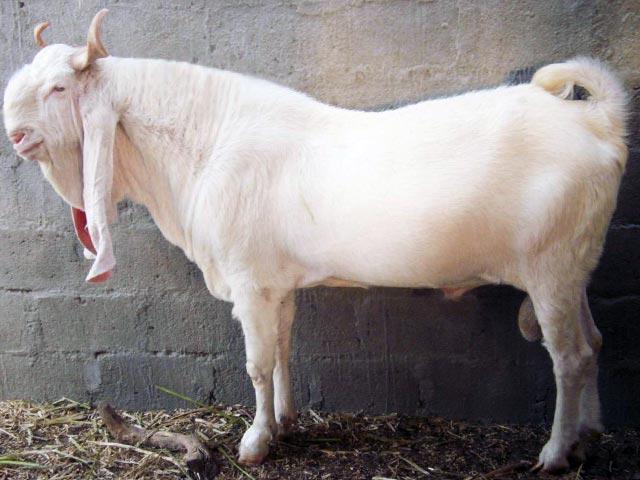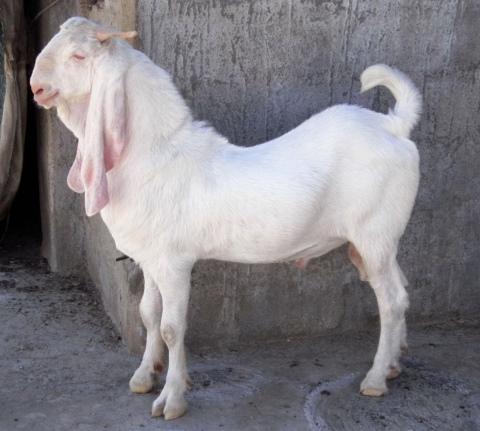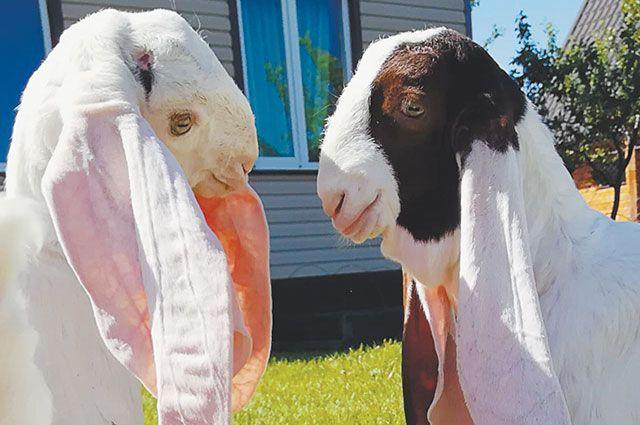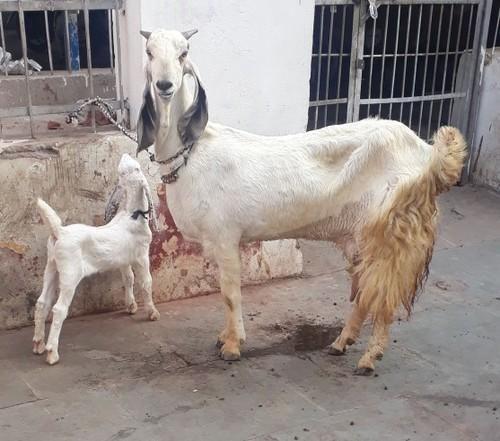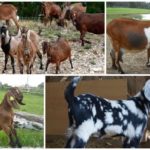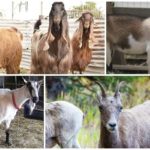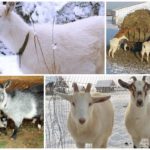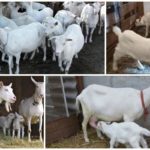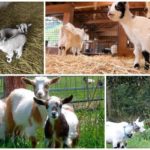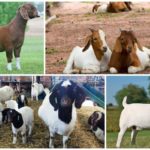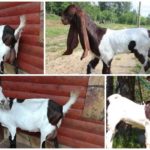Gulabi is a rare breed of goat with long ears that lives in hot climates. In our latitudes, animals can also be bred. In summer, goats can graze on pasture and eat fresh grass. They need to prepare hay for the winter. Gulabi begin to be milked from the second year of life, that is, after the first lambing. The milk of this breed is tasty and very fatty, suitable for making cheese.
Origin of the breed
Gulabi goats are rare animals in our area with long ears hanging down to the knees. They come from Pakistan and India. We call gulabi oriental goats.These animals are considered an exotic breed and cost from $500 each.
The word “gulabi” itself means “pink”. This does not apply to the color of the coat, it is white in goats. Gulabi's skin color is pink. In their homeland these animals are called basi. Their ancestors are considered Kamori goats and breeds with white coat color.
Selection has been carried out by Pakistani and Indian goat breeders for many centuries. Only white animals with long ears were selected. Gulabi crossbreeds have red and brown spots on the head or other parts of the body. Goats of this breed are bred in many hot Asian countries, because it is the short white hair and long thin ears that save the animals from overheating. True, gulabi adapt well to the climate of the middle zone. In winter, they need to be kept in a warm room where the air temperature is not lower than 15 degrees Celsius.
Description and characteristics of gulabi
Goats of this breed have an unusual appearance. First of all, the long, thin, wide, soft ears hanging in folds down to the knees are striking. At home, in hot climates, they help regulate heat exchange. Long ears prevent the goats' body from overheating. The head is small, but a little unusual. The nasal bone has a hump. There is a skin suspension under the lower jaw. The neck is long and muscular.
These animals have high and strong legs. The body is muscular, elongated, compact. The coat is white, but short. Gulabi reach a meter in height at the withers. Weight - 50-90 kilograms. The udder is medium-sized, cup-shaped, with long nipples, perfect for machine milking.
The milk has a pleasant creamy-sweet taste. It doesn't smell like goat. Milk contains almost 4 percent casein. It does not cause allergies, is very nutritious and is suitable for making cheese. From 10 liters of milk 1.3 kg of goat cheese is obtained.
Main pros and cons
Advantages of the Gulabi breed:
- high milk yield rates (1-4 liters per day);
- milk fat content – 5%;
- casein protein content – 4%;
- the ability to make cheese from milk;
- udder convenient for machine milking;
- suitable for meat and dairy farming;
- calm character.
Flaws:
- high price;
- the need for quality feed;
- females bring one kid each;
- For fertilization and prolongation of lactation, a goat of the Gulabi breed is needed.
Rules for keeping and caring for animals
This heat-loving breed of goats can graze on pastures in the summer. However, in rainy weather it is not recommended to take gulabi out into the meadow. It is not advisable for goats to eat grass that is wet or has dew.
In winter, this breed must be kept in a special non-residential building. It can be a shed made of brick, wood or gas silicate, foam concrete blocks. In the room where goats are kept, the temperature should be maintained at 15 to 20 degrees Celsius all year round. Ventilation is installed in the barn, and infrared lamps are purchased for heating in winter. A straw bedding is laid on the floor, which is replaced with a clean one when it gets dirty. There should be a feeder and drinking bowl in the room. You can water goats from a bucket. One animal should have at least 2-4 square meters of area.
Gulabi is fed three times a day. Goats are milked only after the first lambing, the frequency is 2 times a day.Animals must be kept warm and clean, otherwise they will get sick. They don't need to comb their fur. This is a short-haired breed. Gulabi's fur does not tangle or form tangles. In addition, the coat is adapted to self-cleaning from straw and grass. It is only necessary to treat fleas and worms once a quarter.
What is the breed fed?
There is a myth that you can feed goats anything. This is wrong. Not only the well-being of animals, their ability to reproduce healthy offspring, but also milk yield depends on nutrition. The better the animals are fed, the more nutritious their milk.
Gulabi must eat meadow grass. In summer they can be grazed on pasture all day long. In winter, animals are given sun-dried meadow hay. In winter, the diet of goats can include spring straw, birch and oak branches, cake, silage, bran, cereals - oats, barley, corn. Animals are allowed to be fed vegetables and root vegetables (carrots, cabbage, fodder beets, pumpkin). Salted porridge is made from the grain. Vegetables are given finely chopped.
The main food for gulabi is fresh grass in summer and hay in winter. Goats need to be given clean water twice a day. In winter, you can add pharmaceutical vitamin supplements to your drink, definitely vitamin D. It is also recommended to give goats a little salt, mineral preparations, crushed chalk, and bone meal.
Rules for breeding gulabi goats
This breed has a friendly and calm character. Gulabis are like dogs. They quickly become attached to their owner, follow him, sleep at the door of the house, waiting for a person. Goats respond to their names; they are unobtrusive, phlegmatic, and rarely bleat.
This breed can be kept in any household, even in the country.Gulabi will definitely make friends with other animals, for example, cats or dogs. Goats of this breed do not eat much, about 4 kg of grass per day. For the winter they need to prepare at least 500 kg of hay, that’s 25 bales weighing 20 kg each.
Gulabi begin to be milked only after the first birth. The first mating is carried out when the females are 12-18 months old, not earlier. Body weight must be at least 40 kg. Pregnancy in goats lasts 5 months. At the first lambing, the goat gives birth to one baby. With the uterus, the kid is left for up to 3-4 months.
Common diseases and methods of their treatment
If gulabi are kept clean and warm and fed with high-quality food, then they will not get sick. True, the condition of animals should always be closely monitored. Healthy goats eat well and produce their milk quota.
Sick people refuse food, their body temperature rises, cough, nasal discharge, constipation or diarrhea appear.
Animals suffer from infectious and non-contagious diseases that arise as a result of improper metabolism (obesity, osteodystrophy, ketosis). At the age of 3-4 months, goats are vaccinated against rabies, brucellosis, anthrax and foot-and-mouth disease. Goats are often vaccinated against tetanus and tick-borne encephalitis.
During the cold season, animals that are not kept properly develop respiratory diseases. Various medications are used for treatment, including antibiotics. As a preventive measure, it is recommended to keep gulabi in favorable conditions, that is, warm, not damp or drafty, and feed them dried chamomile, coltsfoot, sage, and St. John's wort.
If improperly fed, animals develop diseases of the digestive system (blockage of the esophagus, stomatitis, gastroenteritis, poisoning).Diseases can be prevented by feeding animals high-quality, fresh, not wet food, free from mold and contaminants. It is recommended to finely chop root vegetables. It is necessary to ensure that animals do not swallow foreign objects (pieces of wire, whole vegetables).
Gulabi may have udder problems. The disease can be prevented by not keeping animals in drafts, wet and dirty bedding. If cracks appear on the nipples, the udder is washed with a solution of boric acid and lubricated with petroleum jelly. In case of complications, it is imperative to show the gulabi to a veterinarian.

